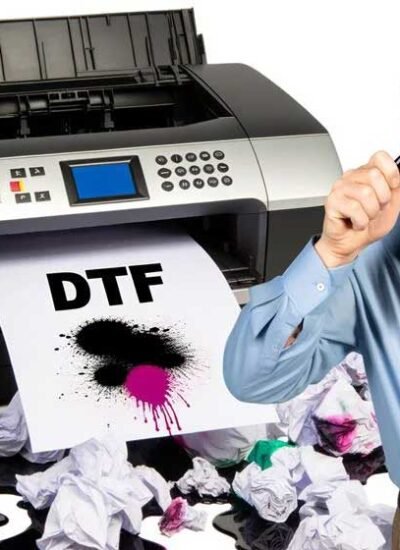DTF (Direct to Film) printing is transforming the world of custom apparel, offering vibrant colors and strong durability across various fabrics. However, like any printing process, DTF comes with its share of challenges. Smudging, peeling, fading, and adhesion failures can turn a promising project into wasted materials and frustration. Fortunately, most of these issues have simple fixes.
If you’re struggling with inconsistent prints, this troubleshooting guide will help you identify common DTF printing mistakes and show you how to resolve them efficiently.
Understanding Common DTF Printing Mistakes
Errors in DTF printing usually result from improper equipment settings, low-quality materials, or skipped maintenance steps. Many problems can be avoided by following best practices and ensuring proper machine calibration. Understanding where things go wrong is the first step to perfecting your prints.
Top DTF Printing Mistakes and How to Fix Them
1. Poor Print Quality (Faded, Blurry, or Smudged Prints)
Blurry or faded prints often indicate issues with resolution, ink flow, or film quality. If your prints lack sharpness or appear washed out, your printer settings might not be optimized for high-resolution output. Always work with designs at 300 DPI or higher to maintain clarity.
The quality of your DTF film also plays a significant role in print sharpness. Inferior films don’t hold ink well, leading to bleeding and smudging. Investing in high-quality DTF film ensures the ink adheres properly, preventing unwanted blurs.
Excessive moisture can also be a culprit. DTF ink needs a dry environment to cure correctly. If humidity levels are too high, the ink might spread unevenly, reducing print quality. Storing your materials in a controlled space will help maintain consistency.
2. Ink Not Adhering Properly to the Film
When ink doesn’t stick to the film as expected, it’s often due to clogged printheads or low-quality film. Over time, ink buildup can block the printheads, leading to uneven ink distribution. Regular printhead cleaning prevents blockages and ensures smooth operation.
Film compatibility is another critical factor. Some films don’t work well with certain ink formulations, resulting in poor adhesion. Choosing a film specifically designed for your DTF printer helps eliminate this issue. Additionally, the ink must be fully dried before moving to the next step—rushing the process can cause adhesion failures. Proper curing and careful handling during the heat press phase are essential to achieving a durable and vibrant DTF transfer.
3. White Ink Separation or Poor Opacity
White ink plays a vital role in making colors pop, especially on dark fabrics. However, it’s prone to separation, causing prints to appear dull or uneven. White ink contains heavy pigments that settle quickly, so it must be shaken regularly before use.
Another common issue is incorrect curing temperature. If the white ink isn’t cured properly, it won’t form a solid base, leading to faded or patchy designs. Adjusting the curing temperature ensures a strong, even foundation for vibrant prints.
4. Film Not Transferring Correctly to Fabric
Sometimes, after pressing, the film doesn’t release cleanly from the fabric, leaving behind incomplete designs or a sticky residue. This usually points to incorrect heat press settings. If the temperature is too low or the pressure is uneven, the transfer won’t bond properly.
Checking your heat press platen for cold spots helps ensure consistent heat distribution. Additionally, the peeling method matters—some films require hot peeling immediately after pressing, while others need to cool down before removal. Using the correct peeling technique prevents damage to the design.
5. Powder Adhesive Issues (Uneven or Excessive Application)
DTF powder adhesive is essential for bonding ink to fabric, but uneven application can lead to poor adhesion or patchy prints. If too much powder is applied, it may clump or create a rough texture. Too little powder, on the other hand, won’t provide enough grip, causing parts of the design to peel off.
A powder shaker ensures even coverage, preventing excess buildup. Curing the powder at the right temperature is also crucial—under-curing results in weak bonds, while over-curing makes the adhesive brittle. The goal is to achieve a smooth, consistent layer that enhances durability without affecting flexibility.
6. Prints Cracking or Peeling After Washing
A DTF print might look perfect at first but start cracking or peeling after a few washes. This is often caused by low-quality materials or improper pressing techniques. High-quality film and adhesive play a major role in ensuring durability.
Pressing for the correct amount of time allows the ink, adhesive, and fabric to fuse properly. Cutting corners during this step weakens the bond, making prints prone to damage. It’s also important to follow proper washing instructions—waiting 24 to 48 hours before the first wash helps the design set fully. Gentle washing cycles and avoiding high heat will extend the life of the print.
7. Ghosting or Double Images on Prints
Ghosting occurs when a faint second image appears on the final print, making it look blurry or misaligned. This usually happens when the transfer film shifts during pressing. Securing the film with heat-resistant tape minimizes movement.
Excessive pressure can also cause the film to shift slightly, especially if the heat press isn’t properly aligned. Keeping the press steady when lifting prevents accidental movement, ensuring crisp, clean designs.
Preventative Maintenance Tips for DTF Printing
Regular maintenance keeps DTF printers running smoothly and prevents common issues. Cleaning printheads frequently reduces clogging, while storing inks and films in a cool, dry place preserves their quality. Heat presses should be checked for temperature accuracy every few weeks to maintain consistent performance.
A reliable printer also makes a difference. The Epson F2270 hybrid printer is known for its precision and efficiency, helping users minimize errors and streamline production. Using high-quality equipment eliminates many troubleshooting headaches from the start.
Conclusion
DTF printing offers incredible possibilities, but achieving flawless results requires attention to detail. Most common mistakes—such as poor adhesion, incorrect heat settings, and improper ink usage—are easy to fix with the right approach.
By investing in quality materials, fine-tuning your process, and maintaining your equipment, you can produce durable, high-quality prints that stand out. With practice and patience, DTF printing can become a smooth, efficient workflow that delivers professional results every time.





Leave a Reply